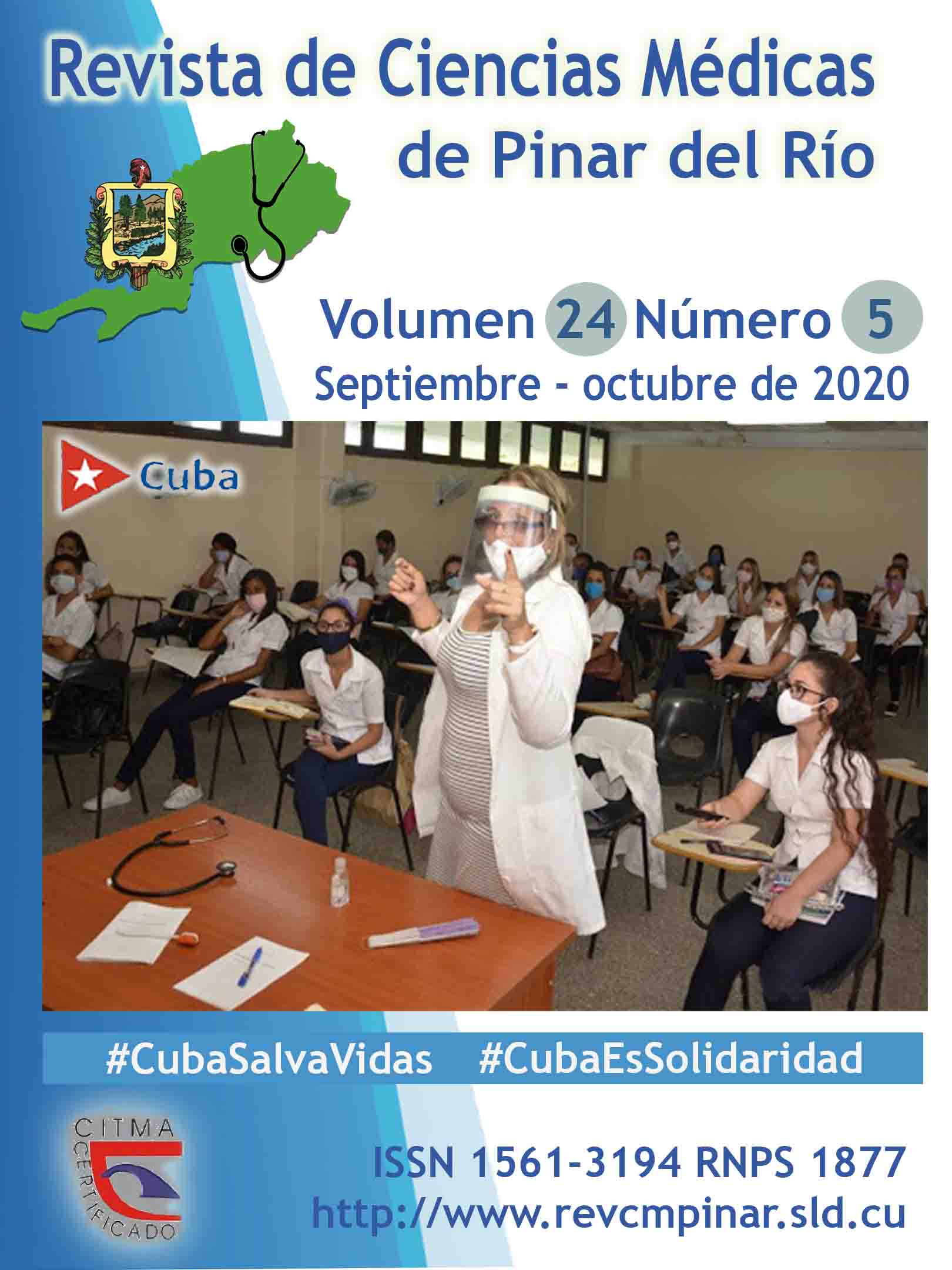Advances in the methodological work on the main comprehensive discipline of dentistry studies
Keywords:
EMPLOYEE DISCIPLINE, STOMATOLOGY CAREER, METHODOLOGICAL WORKAbstract
Introduction: the evaluation of the didactic competences of professors in Medical Education becomes a basic pillar to ensure that the graduates perform their work efficiently and accomplish their social responsibility: excellence in the satisfaction of services aimed at improving the health status of the population.
Objective: to identify the advances of methodological work on the main comprehensive discipline of dentistry studies at Victoria de Giron School of Medicine.
Methods: a longitudinal descriptive study was carried out in the methodological work developed on the main comprehensive discipline in which theoretical methods were applied: analysis-synthesis, deduction-induction and historical-logical; along with empirical methods: documentary analysis of the curricula and methodological guidelines, arrangement of the methodological work, annual reports, minutes of methodological meetings and resolutions; in addition, interviews were conducted with key informers.
Results: the most relevant aspects of the methodological work of the discipline in each stage were exposed, from its beginnings, putting emphasis on the protagonists as well as on their achievements, as evidence of the commendable efforts made.
Conclusions: the positive advances of the methodological work carried out by the main comprehensive discipline of dentistry studies at Victoria de Giron School of Medicine from its beginnings to the current projection were identified, which reflects the leading role on the methodological training of their professors.
Downloads
References
1. Barreto Rodríguez H, González Rodríguez E, Romero Zaldívar E, García Abreu D. Potenciación de elementos teóricos para una mejor interdisciplinariedad ortodóncico-periodontal. MEDISAN [Internet]. 2017 [citado 11/12/2019]; 21(10): [aprox. 0p.]. Disponible en: http://www.medisan.sld.cu/index.php/san/article/view/1087
2. Borrero RY, Gamboa ME. La dirección de la gestión didáctica en la Disciplina Principal integradora de las carreras pedagógicas. Didasc@lia: Didáctica y Educación [Internet]. 2016 [citado 11/12/2019]; 7(5): 13-32. Disponible en: https://core.ac.uk/download/pdf/288101839.pdf
3. Díaz Valdés L, Pérez García LM. La evaluación de la competencia didáctica en el ámbito de la Educación Médica. Gac Méd Espirit [Internet]. 2017 Abr [citado 11/12/2019]; 19(1): 10-15. Disponible en: http://scielo.sld.cu/scielo.php?script=sci_arttext&pid=S1608-89212017000100003&lng=es
4. Díaz Valdés L, Pérez García LM, Calderón Mora MM, Fardales Macías VE, Valdés Quesada ÁE, Palau Rodríguez CM. Diagnóstico del proceso de evaluación de la competencia didáctica de los profesores de Estomatología. Gac Méd Espirit [Internet]. 2017 Dic [citado 11/12/2019]; 19(3): 29-47. Disponible en: http://scielo.sld.cu/scielo.php?script=sci_arttext&pid=S1608-89212017000300004&lng=es
5. Díaz Valdés L, Pérez García LM, Calderón Mora MM, Sánchez Rodríguez L. El perfeccionamiento del proceso de evaluación de la competencia didáctica en Estomatología. Educ Med Super [Internet]. 2018 Dic [citado 11/12/2019]; 32(4): 80-94. Disponible en: http://scielo.sld.cu/scielo.php?script=sci_arttext&pid=S0864-21412018000400009&lng=es
6. González Rodríguez S, Pedroso Ramos L, Rosales Reyes SÁ. Contribución de la Disciplina Estomatología Integral al Análisis de la Situación de Salud Bucal. Revista Habanera de Ciencias Médicas [Internet]. 2015 [citado 11/12/2019]; 14(2): [aprox. 0p.]. Disponible en: http://www.revhabanera.sld.cu/index.php/rhab/article/view/542
7. Grau León I, Barciela González Longoria MC, Peguero Morejón H, Rodríguez Méndez G, Cabo García R. Gestión curricular de la carrera de Estomatología. Facultad de Estomatología de La Habana. 2008-2013. Rev EDUMECENTRO [Internet]. 2015 Mar [citado 11/12/2019]; 7(1): 31-43. Disponible en: http://scielo.sld.cu/scielo.php?script=sci_arttext&pid=S2077-28742015000100004&lng=es
8. Taureaux Díaz N, Miralles Aguilera EÁ, Pernas Gómez M, Diego Cobelo JM, Blanco Aspiazu MÁ, Oramas González R. El perfeccionamiento de la disciplina principal integradora en el plan de estudio de la carrera de Medicina. Rev haban cienc méd [Internet]. 2017 Feb [Citado 11/12/2019]; 16(1): 71-81. Disponible en: http://scielo.sld.cu/scielo.php?script=sci_arttext&pid=S1729-519X2017000100008&lng=es
9. Guerra Pando JA, Coste Reyes J, Carmona Concepción JA. Los modos de actuación profesional: necesidad y reto en el proceso formativo de la carrera de Estomatología. Rev Ciencias Médicas [Internet]. 2016 Feb [citado 11/12/2019]; 20(1). Disponible en: http://scielo.sld.cu/scielo.php?script=sci_arttext&pid=S1561-31942016000100019&lng=es
10. Legañoa Alonso J, Rodríguez Ramos S, Molero Porto V, Castellano Zamora M, Souto Nápoles Y. Valoración curricular de la asignatura Atención Integral a la Familia. Humanidades Médicas [Internet]. 2016 [citado 11/12/2019]; 16(2): [aprox. 15p.]. Disponible en: http://humanidadesmedicas.sld.cu/index.php/hm/article/view/979
11. Lineamientos económicos y sociales del Partido y la Revolución, VI Congreso del Partido Comunista de Cuba, 18 de abril del 2011, página 58.
12. MES. RESOLUCIÓN No. 210 del 31 de julio del 2007. Reglamento para el Trabajo Docente y Metodológico en la educación superior. La Habana. Gaceta Oficial de la República.
13. MES. RESOLUCIÓN No. 2 del 17 de enero del 2018. Reglamento para el Trabajo Docente y Metodológico en la educación superior. La Habana. Gaceta Oficial de la República.
14. Pernas Gómez M. Trabajo metodológico: vía para dirigir el proceso enseñanza aprendizaje, no algoritmo de tareas. Edumecentro [Internet]. 2014 [citado 11/12/2019]; 6(1): [aprox. 18p.]. Disponible en: http://www.revedumecentro.sld.cu/index.php/edumc/article/view/375
15. Yanes Ruiz P, Sosa Morales DE, Cobas Vilches ME. Progresión del trabajo metodológico en la carrera Estomatología en Villa Clara: una aproximación necesaria. Rev EDUMECENTRO [Internet]. 2014 [citado 11/12/2019]; 6(Suppl 1): 103-117. Disponible en: http://scielo.sld.cu/scielo.php?script=sci_arttext&pid=S2077-28742014000400009&lng=es
Downloads
Published
How to Cite
Issue
Section
License
Authors who have publications with this journal agree to the following terms: Authors will retain their copyrights and grant the journal the right of first publication of their work, which will be publication of their work, which will be simultaneously subject to the Creative Commons Attribution License (CC-BY-NC 4.0) that allows third parties to share the work as long as its author and first publication in this journal are indicated.
Authors may adopt other non-exclusive license agreements for distribution of the published version of the work (e.g.: deposit it in an institutional telematic archive or publish it in a volume). Likewise, and according to the recommendations of the Medical Sciences Editorial (ECIMED), authors must declare in each article their contribution according to the CRediT taxonomy (contributor roles). This taxonomy includes 14 roles, which can be used to represent the tasks typically performed by contributors in scientific academic production. It should be consulted in monograph) whenever initial publication in this journal is indicated. Authors are allowed and encouraged to disseminate their work through the Internet (e.g., in institutional telematic archives or on their web page) before and during the submission process, which may produce interesting exchanges and increase citations of the published work. (See The effect of open access). https://casrai.org/credit/



